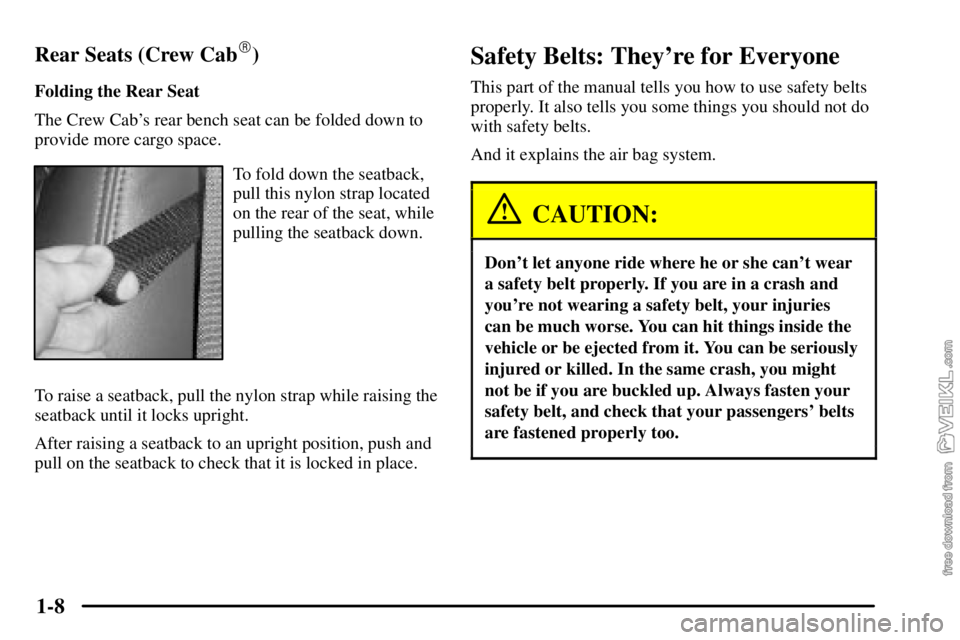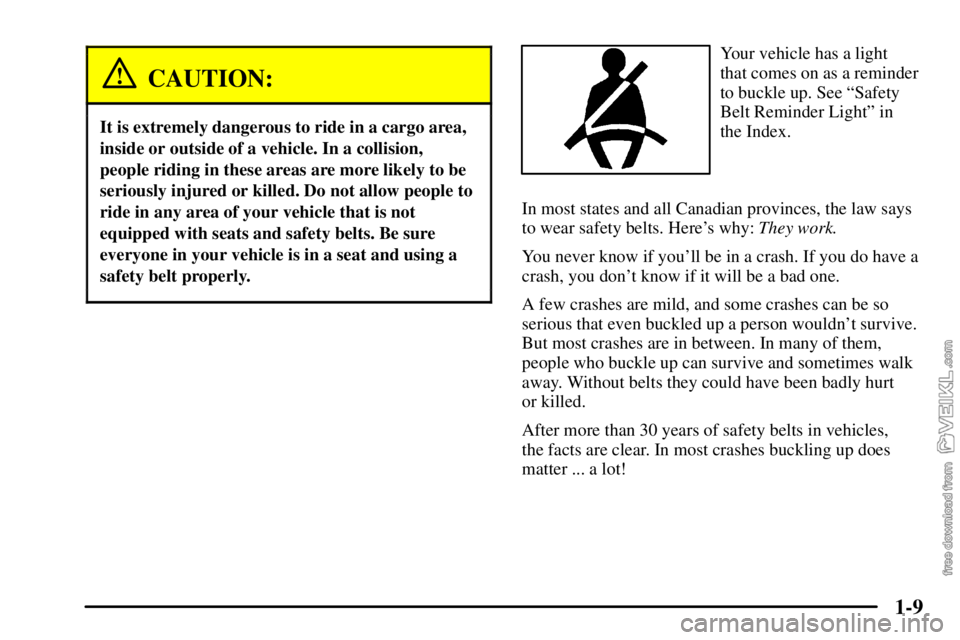Page 2 of 386
i
1-1 Seats and Restraint Systems
Page 8 of 386
1-
1-1
Section 1 Seats and Restraint Systems
Here you'll find information about the seats in your vehicle and how to use your safety belts properly. You can also
learn about some things you should not do with air bags and safety belts.
1
-2 Seats and Seat Controls
1
-8 Safety Belts: They're for Everyone
1
-12 Here Are Questions Many People Ask About
Safety Belts
-- and the Answers
1
-13 How to Wear Safety Belts Properly
1
-13 Driver Position
1
-21 Safety Belt Use During Pregnancy
1
-22 Right Front Passenger Position
1
-22 Air Bag System1
-36 Center Passenger Position
1
-37 Rear Seat Passengers
1
-41 Children
1
-45 Restraint Systems for Children
1
-64 Older Children
1
-67 Safety Belt Extender
1
-67 Checking Your Restraint Systems
1
-68 Replacing Restraint System Parts
After a Crash
Page 9 of 386
1-2
Seats and Seat Controls
This section tells you about the seats in your vehicle and
how to adjust them. It also tells you about reclining front
seatbacks.
CAUTION:
You can lose control of the vehicle if you try to
adjust the seat while the vehicle is moving. The
sudden movement could startle and confuse you,
or make you push a pedal when you don't want
to. Adjust the driver's seat only when the vehicle
is not moving.
Bucket Seats (If Equipped)
If your vehicle has bucket seats, also known as static
seats, you can adjust them forward or rearward with the
lever located at the front of the seat.
To adjust the seat, pull the lever up to release the seat
bottom. Slide the seat to where you want it and release
the lever. Then try to move the seat with your body, to
make sure the seat is locked in place.
Page 10 of 386
1-3 Split Bench Seat (If Equipped)
If your vehicle has a split bench seat, your seat is fixed
and is not able to be adjusted.
Air Suspension Seats (If Equipped)
If your vehicle has the low-back suspension seat, there
are six ways you can adjust the seat.
If your vehicle has the high
-back air suspension seat,
there are five ways you can adjust the seat.Height Adjustment
The suspension seat height
adjustment lever is located
on the front inboard side of
the seat.
To adjust the height of the air suspension seat, pull the
lever up to inflate. Push the lever down to deflate.
The seat cushion itself can also be raised or lowered.
Page 13 of 386
1-6
Chugger-Snubber Lock-Out Feature (If Equipped)
If your vehicle has this
feature, the handle is
located on the outboard
sides of the driver's and
passenger's seats.
Move the handle down to minimize any backslap
experienced while in tractor/trailer operation or while
operating a dump truck application. This feature is only
available on low
-back seats.
Reclining Front Seatbacks (If Equipped)
If your vehicle is equipped with bucket seats, you can
recline the seatbacks. The lever is located on the
outboard side of the seat cushion.
To recline the seatback, lift the lever and use your body
to move the seatback. Release the lever to lock the
seatback where you want it. Lean forward and pull up
on the lever to return the seatback to an upright position.
Page 15 of 386

1-8 Rear Seats (Crew Cab
�)
Folding the Rear Seat
The Crew Cab's rear bench seat can be folded down to
provide more cargo space.
To fold down the seatback,
pull this nylon strap located
on the rear of the seat, while
pulling the seatback down.
To raise a seatback, pull the nylon strap while raising the
seatback until it locks upright.
After raising a seatback to an upright position, push and
pull on the seatback to check that it is locked in place.
Safety Belts: They're for Everyone
This part of the manual tells you how to use safety belts
properly. It also tells you some things you should not do
with safety belts.
And it explains the air bag system.
CAUTION:
Don't let anyone ride where he or she can't wear
a safety belt properly. If you are in a crash and
you're not wearing a safety belt, your injuries
can be much worse. You can hit things inside the
vehicle or be ejected from it. You can be seriously
injured or killed. In the same crash, you might
not be if you are buckled up. Always fasten your
safety belt, and check that your passengers' belts
are fastened properly too.
Page 16 of 386

1-9
CAUTION:
It is extremely dangerous to ride in a cargo area,
inside or outside of a vehicle. In a collision,
people riding in these areas are more likely to be
seriously injured or killed. Do not allow people to
ride in any area of your vehicle that is not
equipped with seats and safety belts. Be sure
everyone in your vehicle is in a seat and using a
safety belt properly.
Your vehicle has a light
that comes on as a reminder
to buckle up. See ªSafety
Belt Reminder Lightº in
the Index.
In most states and all Canadian provinces, the law says
to wear safety belts. Here's why: They work.
You never know if you'll be in a crash. If you do have a
crash, you don't know if it will be a bad one.
A few crashes are mild, and some crashes can be so
serious that even buckled up a person wouldn't survive.
But most crashes are in between. In many of them,
people who buckle up can survive and sometimes walk
away. Without belts they could have been badly hurt
or killed.
After more than 30 years of safety belts in vehicles,
the facts are clear. In most crashes buckling up does
matter ... a lot!
Page 20 of 386

1-13
Q:If I'm a good driver, and I never drive far from
home, why should I wear safety belts?
A:You may be an excellent driver, but if you're in an
accident
-- even one that isn't your fault -- you
and your passengers can be hurt. Being a good
driver doesn't protect you from things beyond your
control, such as bad drivers.
Most accidents occur within 25 miles (40 km)
of home. And the greatest number of serious
injuries and deaths occur at speeds of less
than 40 mph (65 km/h).
Safety belts are for everyone.
How to Wear Safety Belts Properly
Adults
This part is only for people of adult size.
Be aware that there are special things to know about
safety belts and children. And there are different rules
for smaller children and babies. If a child will be riding
in your vehicle, see the part of this manual called
ªChildren.º Follow those rules for everyone's
protection.
First, you'll want to know which restraint systems your
vehicle has.
We'll start with the driver position.
Driver Position
This part describes the driver's restraint system.
Lap-Shoulder Belt
The driver has a lap-shoulder belt. Here's how to wear
it properly.
1. Close and lock the door.
2. Adjust the seat so you can sit up straight. To see
how, see ªSeatsº in the Index.